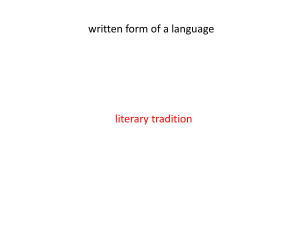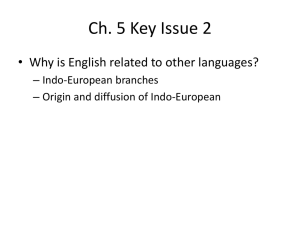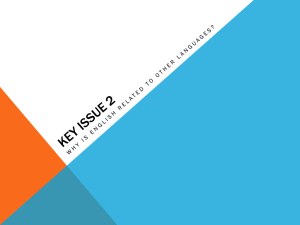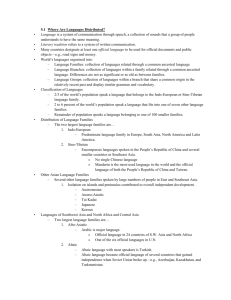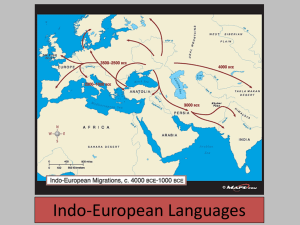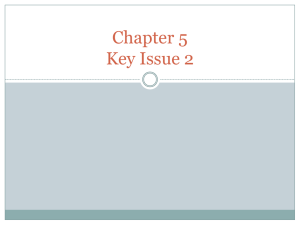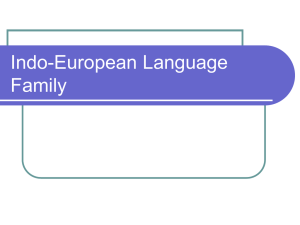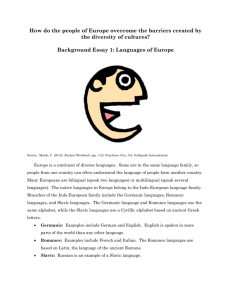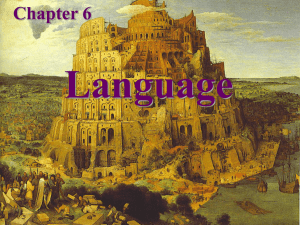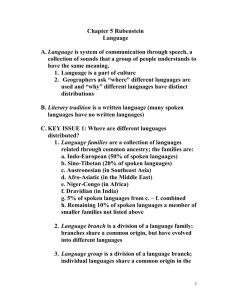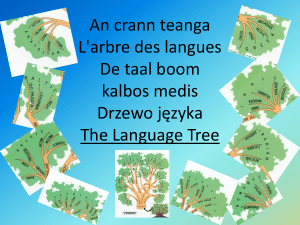Chapter 5 Key Issue #2
advertisement
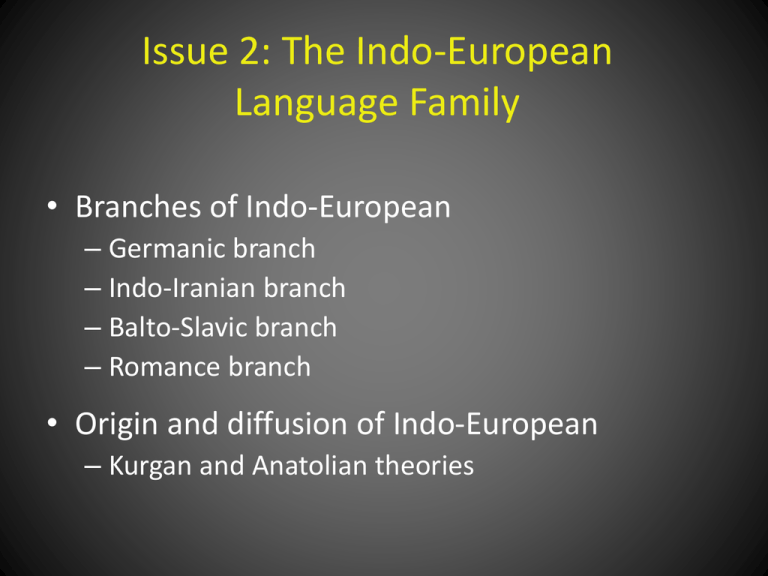
Issue 2: The Indo-European Language Family • Branches of Indo-European – Germanic branch – Indo-Iranian branch – Balto-Slavic branch – Romance branch • Origin and diffusion of Indo-European – Kurgan and Anatolian theories Indo-European Language Family Fig. 5-5: The main branches of the Indo-European language family include Germanic, Romance, Balto-Slavic, and Indo-Iranian. Germanic Branch of Indo-European • • English and German are both languages in the West Germanic group. West Germanic is further divided into High Germanic and Low Germanic subgroups, so named because they are found in high and low elevations within present-day Germany. – High German, spoken in the southern mountains of Germany, is the basis for the modern standard German language. – English is classified in the Low Germanic subgroup. – The Germanic language branch also includes North Germanic languages, spoken in Scandinavia. – The four Scandinavian languages—Swedish, Danish, Norwegian, and Icelandic—all derive from Old Norse. Fig. 5-6: The Germanic branch today is divided into North and West Germanic groups. English is in the West Germanic group. Indo-Iranian Branch of Indo-European The branch of the Indo-European language family with the most speakers is Indo-Iranian, more than 100 individual languages divided into an eastern group (Indic) and a western group (Iranian). Indic (Eastern) Group of Indo-Iranian Language Branch • The most widely used languages in India, as well as in the neighboring countries of Pakistan and Bangladesh, belong to the Indic group of the Indo-Iranian branch of IndoEuropean. • Approximately one-third of Indians, mostly in the north, use an Indic language called Hindi. • Hindi is spoken many different ways—and therefore could be regarded as a collection of many individual languages but there is only one official way to write the language, using a script called Devanagari. Pakistan • Pakistan’s principal language, Urdu, is spoken very much like Hindi but is written with the Arabic alphabet, a legacy of the fact that most Pakistanis are Muslims, and their holiest book (the Quran) is written in Arabic. • Hindi, originally a variety of Hindustani spoken in the area of New Delhi, grew into a national language in the nineteenth century when the British encouraged its use in government. South Asian Languages and Language Families Fig. 5-7: Indo-European is the largest of four main language families in South Asia. The country of India has 18 official languages. Iranian (Western) Group of Indo-Iranian Language Branch • Indo-Iranian languages spoken in Iran and neighboring countries form a separate group from Indic. • The major Iranian group languages include Persian (sometimes called Farsi) in Iran, Pathan in eastern Afghanistan and western Pakistan, and Kurdish, used by the Kurds of western Iran, northern Iraq, and eastern Turkey. • These languages are written in the Arabic alphabet. Balto-Slavic Branch of Indo-European • Slavic was once a single language, but differences developed in the seventh century A.D. when several groups of Slavs migrated from Asia to different areas of Eastern Europe. East Slavic and Baltic Groups of Balto-Slavic Language Branch • After Russian, Ukrainian and Belarusian (sometimes written Byelorussian) are the two most important East Slavic languages. • The desire to use languages other than Russian was a major drive in the Soviet Union breakup a decade ago. West and South Slavic Groups of BaltoSlavic Language Branch • The most spoken West Slavic language is Polish, followed by Czech and Slovak. • The latter two are quite similar, and speakers of one can understand the other. • The two most important South Slavic languages are Serbo-Croatian and Bulgarian. • Although Serbs and Croats speak the same language, they use different alphabets. • Slovene is the official language of Slovenia, while Macedonian is used in the former Yugoslav republic of Macedonia. Romance Branch of Indo-European Fig. 5-8: The Romance branch includes three of the world’s 12 most widely spoken languages (Spanish, French, and Portuguese), as well as a number of smaller languages and dialects. Origin and Diffusion of Romance Languages • • • • As the conquering Roman armies occupied the provinces of it’s vast empire, they brought the Latin language with them the languages spoken by the natives of the provinces were either extinguished or suppressed. Latin used in each province was based on that spoken by the Roman army at the time of occupation. Each province also integrated words spoken in the area. The Latin that people in the provinces learned was not the standard literary form but a spoken form, known as Vulgar Latin, from the Latin word referring to “the masses” of the populace. After the Fall of Rome • By the eighth century, regions of the former empire had been isolated from each other long enough for distinct languages to evolve. • Latin persisted in parts of the former empire. • People in some areas reverted to former languages, while others adopted the languages of conquering groups from the north and east, which spoke Germanic and Slavic. Romance Language Dialects – France • • • • • • • Distinct Romance languages did not suddenly appear. They evolved over time. The creation of standard national languages, such as French and Spanish, was relatively recent. The dialect of the Ile-de-France region, known as Francien, became the standard form of French because the region included Paris. The most important surviving dialect difference within France is between the north and the south. The northern dialect, langue d’oil and the southern langue d’ôc provide insight into how languages evolve. These terms derive from different ways in which the word for “yes” was said. Romance Language Dialects – Spain • Spain, like France, contained many dialects during the Middle Ages. • In the fifteenth century, when the Kingdom of Castile and Leon merged with the Kingdom of Aragón, Castilian became the official language for the entire country. Spanish and Portuguese Speaking Countries • • • • • Spanish and Portuguese have achieved worldwide importance because of the colonial activities of their European speakers. Approximately 90 percent of the speakers of these two languages live outside Europe. Spanish is the official language of 18 Latin American states, while Portuguese is spoken in Brazil. The division of Central and South America into Portuguese- and Spanish-speaking regions is the result of a 1493 decision by Pope Alexander VI. The Portuguese and Spanish languages spoken in the Western Hemisphere differ somewhat from their European versions. Creole • A creole or creolized language is defined as a language that results from the mixing of the colonizer’s language with the indigenous language. • A creolized language forms when the colonized group makes some changes, such as simplifying the grammar. • The word creole derives from a word in several Romance languages for a slave who is born in the master’s house. Origin and Diffusion of Indo-European • The existence of a single ancestor cannot be proved with certainty, because it would have existed thousands of years before the invention of writing or recorded history. • The evidence that Proto-IndoEuropean once existed is “internal.” • Individual Indo-European languages share common root words for winter and snow but not for ocean. • Therefore, linguists conclude that original Proto-Indo-European speakers probably lived in a cold climate, or one that had a winter season, but did not come in contact with oceans. Kurgan Theory of Indo-European Origin Fig. 5-9: In the Kurgan theory, Proto-Indo-European diffused from the Kurgan hearth north of the Caspian Sea, beginning about 7,000 years ago. Anatolian Hearth Theory of IndoEuropean Origin Fig. 5-10: In the Anatolian hearth theory, Indo-European originated in Turkey before the Kurgans and diffused through agricultural expansion.
